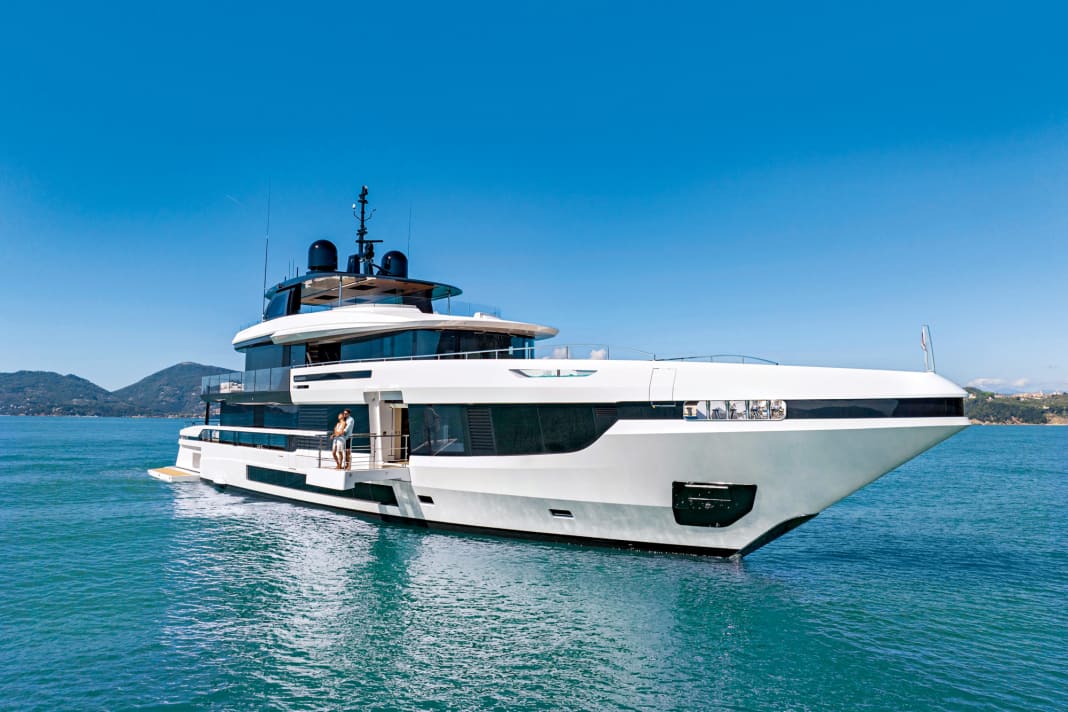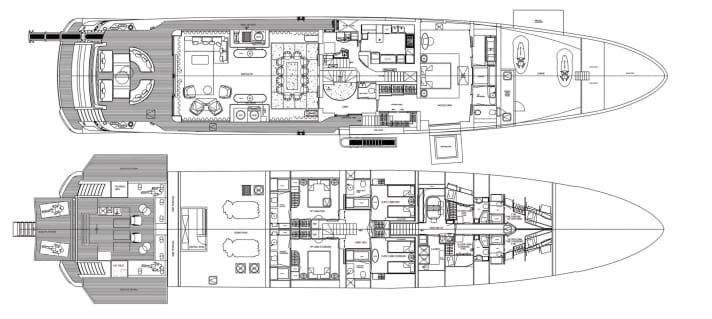Mangusta Oceano 44: Floating luxury loft with infinity pool by Alberto Mancini






Artists draw their inspiration from various sources; in Alberto Mancini's case, it was a typical New York or Miami penthouse with a "boundless" terrace. Transparent glass instead of railings or solid walls, unobstructed views of the sky, land and - if available - water. Such an ambience would also fit perfectly on a superyacht. "A challenge immediately arose in my mind," says the Italian designer, who then made the designers of the Overmarine Group work up a sweat for the Mangusta Oceano 44.
Huge, floor-to-ceiling windows, glass bulwarks for the outer decks - with these ingredients, the Italian company turns the new Mangusta displacers into floating conservatories. When calculating the aluminium superstructures of the 44, the in-house and P.L.A.N.A. designers had to crack many a tough nut. "Losing the bulwarks means a loss of strength," explains Mancini. And adds mischievously: "I really can't remember the details of the discussions. But the project went through many loops before we came to the final result." However, the effort put into the 44.47 metre long and 8.70 metre wide steel and aluminium construction was worth it. "I'm proud of it, it's something unique, and the customers of the Oceano 44 and 39 are already cruising the Mediterranean and enjoying their infinity decks." The Oceano 39 is the youngest and smallest model in the series and is made of GRP.
Mangusta Oceano is considered a "spiritual successor"
Mangusta advertises the 44 as the "spiritual successor" to the 43, the first Oceano, and describes the 400-tonner as a "villa over water" - a title that Mancini also finds quite fitting: "Of course, she is also inspired by the modern architecture of a villa." The unusual upper deck layout of construction number one for a yacht of this size fits in with this. Instead of an additional saloon or a skylounge with sliding glass doors on three sides, the design team placed a second master suite at the rear. In a penthouse on land, the residents also sleep on the upper floor, nicely undisturbed by the hustle and bustle on the Beletage. In this case, there is only one sliding door to the stern, but it extends across the full width and defines a seamless transition to the outer deck, just like on the aft main deck. "This was an option that we had already considered at the beginning of the layout planning," says Mancini. "In fact, the glass panels emphasise the dramatic view, which is unique in this class of yacht."
As there is no lounge for the twelve overnight guests up here, there is also no usual dining area on the terrace. The outdoor dining table is located one floor above, elegantly positioned between the bar and lounge, while the indoor version is located two decks below in the saloon. This concept is more than coherent. "It gives you a private owner's terrace. I think it's worth it," says Mancini, commenting on the decision.
Visual highlights
If the owners want to mingle with their guests, they have various open-air areas to choose from. For example, the 104 square metre sun deck and the beach club, which transforms into an airy and spacious water sports base thanks to the platform and folding side terraces, are ideal for a relaxing afternoon. For a break in between, guests can take a seat in the indoor lounge and enjoy a drink from the bar. The very best place to sunbathe, however, is on the forward upper deck. Here you can stretch out on cushions that seem to be lying in the pool, with the water lapping around the outside of what Mancini calls the fun island. Of course, guests can get there on dry land, with a footbridge leading to the berth, which Alberto Mancini visibly describes with enthusiasm as a "Tibetan suspension bridge". Although it doesn't come close to its 270 metre long sister, which hovers over a gorge in Ticino, it is a visual highlight.
The same applies to the staircase, where it is worth stopping for a while to let your gaze wander and take in the whole thing. "We have a modern mosaic of leather, velour and leather with a textured surface," says Mancini, who is also responsible for the interior design. The differently sized graphic elements each shine in two shades of blue and natural colour. He wanted to create the "illusion of a winter garden" with this pattern. Leather art can also be found on the headboard of the upper owner's suite, albeit in a monochrome beige colour. Here, a three-dimensional fish adds a touch of maritime flair to the very understated ambience. Dabs of pink can be found here and there, including in the marble of the bathrooms and in the rose gold fittings.
"Warm, lots of class and inviting minimalism"
Similar shades of colour set the tone in the master suite on the forward main deck. Instead of a large terrace to starboard, the room has a small balcony that can be folded out on request and is perfect for the first coffee in the morning or the last drink in the evening. The partially glass-panelled ceiling makes up for the lack of natural light, while the pattern behind it evokes passing clouds or water plants. In the bathroom, skylights allow the pool to shimmer through, while the water casts exciting plays of light into the room. Access to this oasis of calm is via a spacious dressing room, which residents can reach directly from the hallway of the stairwell. This is where the leitmotif of the interior can be recognised, which Mancini sums up as follows: "Warm, lots of class and inviting minimalism - that's my motto."
Mancini's preference for marble is also evident in the lounge. The natural stone, white-grey Calacatta to be precise, even covers the floor under the lounge furniture and the dining area for twelve guests. As the tops of the Minotti coffee tables are adorned with exactly the same marble, they appear to merge with the base. Otherwise, the designer again worked tone on tone, with the leather of the filigree seating group in the same colour as the wall and ceiling panelling. The chairs are also beige in colour, which contrasts with the high-gloss table top - with marble insert - and the reflective ceiling panel above. Even the modern chandelier keeps a low profile.
Wheelhouse of the Mangusta Oceano 44 becomes a quiet place
This tranquillity is also evident in a place that you might not have expected: the wheelhouse. Floor-to-ceiling windows provide an excellent view, but together with the command centre, which is positioned almost in the middle of the room and virtually free-standing, it is more reminiscent of a living room than the realm of the captain. There is plenty of space around the monitors and displays on the bridge, and the two voluminous, swivelling and tilting captain's chairs look as if they are more than comfortable to sit in. Whilst the yacht is rushing through the waves at up to 16 knots with the help of the two twelve-cylinder MTU engines, guests can comfortably discuss the itinerary for the day ahead. This bridge set-up is no coincidence for designer Mancini: "The wheelhouse is becoming increasingly important. Owners want to spend more time here, enjoy the journey from a higher position and look out over the sea from there." It goes without saying that the latter activity takes place without restricting the view.
Technical data



- Length over everything:44,47 m
- Width: 8,70 m
- Depth: 2,45 m
- Displacement (50 %): 400 t
- Gross tonnage: 472 Gross tonnes
- Material: Steel/aluminium
- Motors: 2 x MTU V12
- Engine power: 2 x 1268 kW
- Emission class: IMO Tier II, EPA Tier 3
- Speed (max.): 15.5 kn
- Speed (travelling): 11 kn
- Range:4500 nm
- Stabilisers:electric, zero speed
- Fuel: 71 600 l
- Water: 13 800 l
- Guests: 12
- Crew: 9
- Construction: P.L.A.N.A., Overmarine Group
- Exterior design: Alberto Mancini
- Interior design: Alberto Mancini
- Shipyard:Overmarine, 2022

